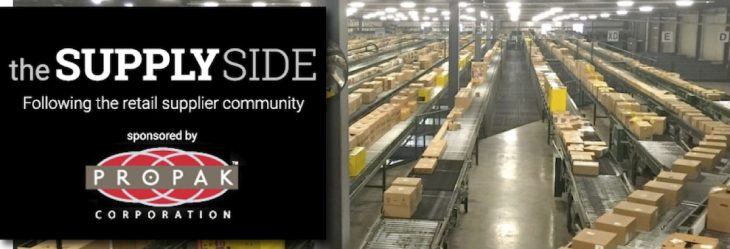The Supply Side: Walmart, Target finding success with different ‘Amazon’ strategies
by September 15, 2019 4:32 pm 4,502 views

Walmart and Target are the two largest big-box general merchandise retailers in the U.S. by total sales. Headquartered 644 miles apart, the two retail giants are finding favor with Wall Street and consumers according to recent better-than-expected earnings.
That said, the game plan each retailer is following is different. Walmart and Target both have Amazon breathing down their necks. Each has devised a strategy to take e-commerce share from Amazon and still protect their margins and run profitable stores.
Annibal Sodero, a supply chain research analyst at Ohio State University, gave Target high praise for its $550 million acquisition of Shipt in December 2017. It was one of the largest acquisitions in Target’s history and gave the retailer the ability to provide same-day delivery in a majority of its stores and in all major markets.
Arthur Valdez, chief supply chain & logistics officer at Target, recently spoke via webcast at the Transplace CPG Summit in Bentonville. Valdez said nearly 4 million customers this year have been served with Shipt delivery, using Target stores as the fulfillment center. He said 85% of the U.S. population lives within 10 miles of a Target store. That is a similar footprint to Walmart except more of Walmart’s stores are in second- and third-tier cities and suburban and rural areas.
Valdez said Target’s system of inventory flow starts at the stores and works backward. He said inventory intelligence used upstream helps to ensure Target gets the right level of inventory at the store and fulfillment centers to account for in-store sales and e-commerce sales delivered and fulfilled from the stores.
Because Target has one inventory system, Valdez said the retailer can sort out and break down cases upstream and send only what is needed to the stores. That allows the back of stores to handle the receipt for online orders, which are later delivered by a local carrier network.
Valdez said Target is the No. 2 importer of goods into the U.S. Its stores will be used as micro fulfillment centers in the future. The company wants to get to a 48-hour to 72-hour cycle from order to delivery. The cycle now ranges from five to 10 days.
“Our guests are wanting pickup in an hour or delivered in that time frame,” Valdez said. “Speed is anchored to the supply chain capabilities we are continuing to build. We have one inventory system today. That’s a big advantage. Fed by one point of sale, one body of inventory working for multiple sales channels.”
That is an advantage Walmart does not have. The Northwest Arkansas Business Journal asked Walmart U.S. eCommerce CEO Marc Lore in June when the retailer might get a one inventory system to facilitate all Walmart online orders, whether the orders are grocery or general merchandise. Walmart has two systems and two different apps to handle online orders.
Lore said the retailer is working on the consolidation and predicts it will be done by early next year. Sodero said that’s a promise made before and not kept. He said Walmart knows it needs one system, but integrating two systems that are huge in size and growing isn’t easy.
Walmart continues to add 100 new stores each week to its online grocery pickup. The service is available in 2,700 stores. The retailer has also installed hundreds of pickup towers to handle quick turnaround times for general merchandise orders picked up in-store. The company has also invested in technology unloaders and sorting stations to facilitate the online grocery orders for in-store pickup.
That said, the consumer who places an online grocery order for in-store pickup must use a different app to order the charcoal grill. The customer can use the app to get a prescription refill, but it won’t be added to the grocery order. The consumer could drive up and get groceries loaded in the car, but would still have to drive through the pharmacy line to pick up the prescription, then park the car and go inside the store to the pickup tower or check-in station to get the general merchandise order.
Sodero said that’s just part of the problem with having multiple inventory systems. He said it’s also more cumbersome for suppliers selling online and in stores. He said online products can have different UPC codes than the same item sold in stores, which can make it hard to return a product to the store if purchased online.
Sodero said if he was keeping score, Target would get pick up a point for having the one inventory system, and for acquiring Shipt to give it scale with local deliveries.
He said Walmart’s partnership with Postmates was a step in the right direction. It reportedly would make the online grocery delivery option available to more than 40% of U.S. households. Walmart U.S. CEO Greg Foran said in June that the retailer continues to work with multiple third-party delivery firms and is also experimenting with its own drivers in select markets.
Sodero said it can be difficult for Walmart to manage a plethora of partnerships at the local level given the company’s sheer size. He said Walmart seems more focused on in-store pickup, which may or may not be a long-term ticket for success.
Sodero’s research indicates stores of the future will likely be those that offer great experiences around the shopping event. He said there is nothing satisfying about shopping in aisles cluttered from personal shoppers picking online orders in stores being used as fulfillment centers.
Editor’s note: The Supply Side section of Talk Business & Politics focuses on the companies, organizations, issues and individuals engaged in providing products and services to retailers. The Supply Side is managed by Talk Business & Politics and sponsored by Propak Logistics.



